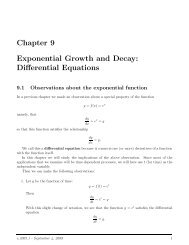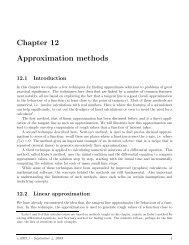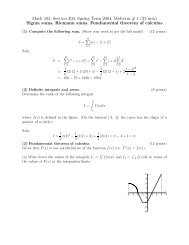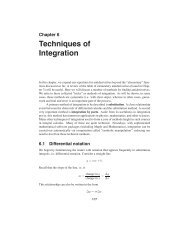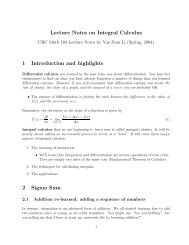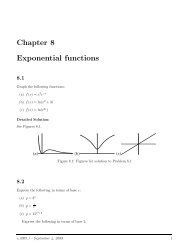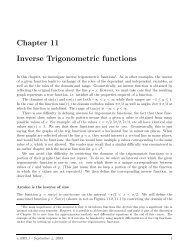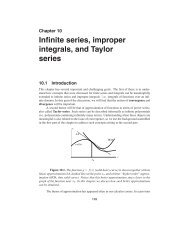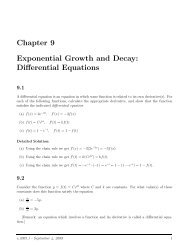Chapter 10 Continuous probability distributions - Ugrad.math.ubc.ca
Chapter 10 Continuous probability distributions - Ugrad.math.ubc.ca
Chapter 10 Continuous probability distributions - Ugrad.math.ubc.ca
- No tags were found...
Create successful ePaper yourself
Turn your PDF publications into a flip-book with our unique Google optimized e-Paper software.
Math <strong>10</strong>3 Notes <strong>Chapter</strong> <strong>10</strong>p(h)p(h)p(h)∆ hh∆ hhhFigure <strong>10</strong>.3: Refining a histogram by increasing the number of bins leads (eventually) to the ideaof a continuous <strong>probability</strong> density.in Figure <strong>10</strong>.3(b)). Here, by a “bin” we mean a little interval of width ∆h where h is height, i.e. aheight interval. For example, we could keep track of the heights in increments of 50 cm. If we wereto plot the number of students in each height <strong>ca</strong>tegory, then as the size of the bins gets smaller,so would the height of the bar: there would be fewer students in each <strong>ca</strong>tegory if we increase thenumber of <strong>ca</strong>tegories.To keep the bar height from shrinking, we might reorganize the data slightly. Instead of plottingthe number of students in each bin, we might plotnumber of students in bin.∆hIf we do this, then both numerator and denominator decrease as the size of the bins is made smaller,so that the shape of the distribution is preserved (i.e. it does not get flatter).We observe that in this <strong>ca</strong>se, the number of students in a given height <strong>ca</strong>tegory is representedby the area of the bar corresponding to that <strong>ca</strong>tegory:( )number of students in binArea of bin = ∆h= number of students in bin.∆hThe important point to consider is that the height of each bar in the plot represents the number ofstudents per unit height.This type of plot is precisely what leads us to the idea of a density distribution. As ∆h shrinks,we get a continuous graph. If we “normalize”, i.e. divide by the total area under the graph, we geta <strong>probability</strong> density, p(h) for the height of the population. As noted, p(h) represents the fractionof students per unit height whose height is h. It is thus a density, and has the appropriate units.More generally,p(x) ∆xrepresents the fraction of individuals whose height is in the range x ≤ h ≤ x + ∆x.<strong>10</strong>.5.2 Examples: Age dependent mortalityLet p(a) be a <strong>probability</strong> density for the <strong>probability</strong> of mortality of a female Canadian non-smoker atage a, where 0 ≤ a ≤ 120. (We have chosen an upper endpoint of age 120 since practi<strong>ca</strong>lly no Canav.2005.1- January 5, 2009 11



